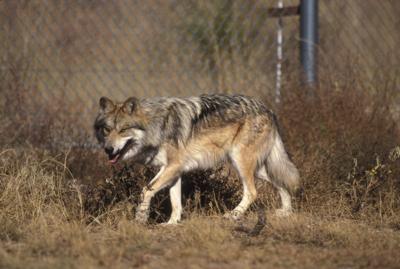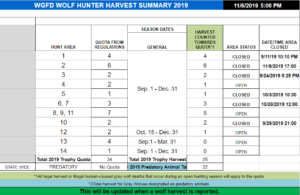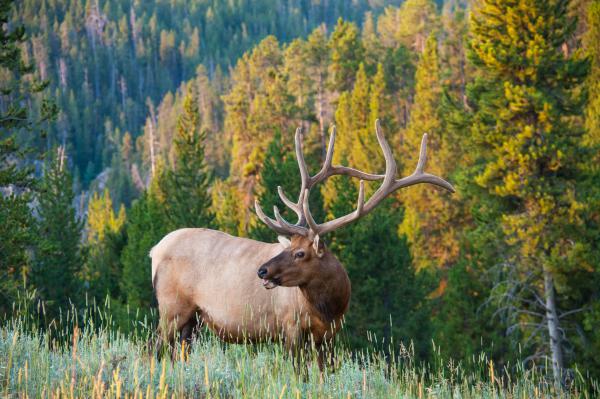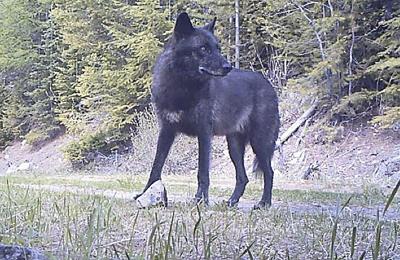
For millions of years, gray wolves roamed this continent.
Thousands of them once lived in Colorado, but by 1935, wolves were effectively extinct here — scientists call it “extirpated” — from gunshots, poisoning and trapping. No one knows for sure where the last wolf died in this state. One writer believes it was in the South San Juans in 1938 (the South San Juans are where Colorado’s last grizzly bear died in 1979). Another speculates the year was 1945, and the wolf’s place of death was Conejos County, on the border of New Mexico.
Wherever that animal took its last breath, one fact about its locale is known for sure. As Fort Lewis College history and environmental studies professor Andrew Gulliford has written in “The Last Stand of the Pack:” “National Park Rangers killed the last wolf in Yellowstone in 1926. In Colorado it took longer because of our vast mountainous terrain and the many plateaus, buttes, prairies and canyons where wolves roamed.”
Wolves hung on longer here than in northwest Wyoming, where they’ve since been successfully restored. If a group of conservationists is persuasive — and the voting public agrees — it could well be the western Colorado wilderness that restores and protects wolves again.
A lot has happened since 1945, after all: wolves have not only been returned to Yellowstone National Park and resided there for 25 years, they’ve roamed (which is what wolves do) across much of the Northern Rockies. Today, they can be found in Wyoming, Idaho, Montana, Washington, Oregon, even California — where a female from the “Lassen pack” gave birth to pups in April. Reviled by many (but not all) ranchers and livestock producers,
Canis lupus has morphed into a cash cow in Yellowstone, at least, which takes in an estimated $35 million annually in “wolf tourism.”
Now a group of passionate conservationists, which has been studying this issue for years, aims to let the voting public decide the wolf’s fate in Colorado. They are giving the public what it says it wants: For years, bipartisan polling has consistently found that voters want the wolf restored here. (A bipartisan, statewide survey conducted in March, for example, found that two-thirds of likely voters agree that wolves should be restored to western Colorado, and only 15 percent opposed it.)
The Rocky Mountain Wolf Action Fund, an entity focused on the ballot initiative, has been gathering signatures in order to get Initiative 107 placed on the ballot next November. About 126,000 signatures are required to be submitted by Dec. 12. Advocates say they now have more signatures than they need.
Initiative 107 would ask voters whether gray wolves should be restored “on designated lands in Colorado located west of the continental divide.” The restoral will be guided by science: If the law passes, Colorado Parks & Wildlife will be charged with “holding statewide hearings and using available data” to implement a plan to manage and protect wolves. The plan would be allowed three years to take effect. The law further instructs CPW to “fairly compensate owners for losses of livestock caused by gray wolves.”
“We have 176,000 raw signatures in hand, with enough booklets in the field at present to carry us far past the 200,000 mark if they are all returned,” said Rob Edward of the wolf action fund. The numbers are “raw” because they haven’t yet been verified by representatives of the State of Colorado. The fund plans to keep gathering signatures right up until the deadline for submittal. “It takes a lot of time for the state to go through all of this” once the signatures are submitted, said action fund adviser Eric Washburn, who hopes the official OK to be listed on the ballot will come in January.
The founding executive director of the Theodore Roosevelt Conservation Partnership (with a Yale University masters degree in forestry), Washburn has “managed a broad coalition of dozens of national hunting and fishing organizations to promote national conservation policies in Washington, D.C.,” according to a press release from the Theodore Roosevelt Presidential Library and Museum promoting Washburn to its board of trustees. He’s used to finding consensus (when that’s possible) for conservation policies, in other words. So the fact that a group of agricultural producers — the Colorado Farm Bureau, Colorado Cattlemen’s Association and Colorado Woolgrowers Association — announced a joint effort to oppose the wolf’s reintroducion called Coloradans Protecting Wildlife on Tuesday didn’t phase him (other opposition groups include the Colorado Stop the Wolf Coalition in Grand Junction and the Rocky Mountain Elk Foundation.)
“We’d been anticipating that there would be more formal efforts to oppose this, and that’s just the way that politics work,” Washburn said. “We do feel good about the arguments on our side, because we’ve got this 25 years of data” (the wolf reintroduction effort began in Yellowstone in 1979). “We’ve got a great story to tell. We know what wolves do in ecosystems with livestock, and with wildlife populations.”
For example, when this reporter read a statement that “Wolf introduction in Idaho, Wyoming and Montana has had a devastating impact on livestock producers,” Washburn was quick to reply.
“Wolves in those states are responsible for less than one-tenth of one percent of livestock mortality. They’re an insignificant factor,” he said. “We keep hearing that if they’re reintroduced to Colorado, wolves will devastate deer and elk,” Washburn added. “Yet there are more elk in Idaho, Wyoming and Montana now than when wolves were first introduced.”
If the reintroduction of wolves does get on the ballot next year, which seems likely, expect the ensuing 11 months to be a blizzard of facts and — as White House counselor Kellyanne Conway famously put it — alternative facts. Restoration advocates have assembled an impressive 28-person scientific advisory team whose collective work with wolves amounts to hundreds of years spent studying them in the field (learn more at
rockymountainwolfproject.org).
Reintroducing the canid will reconnect two great populations of wolves, northern and southern (they are being reintroduced in New Mexico and Arizona), these advocates say. Montana Senator Mike Phillips, who helped lead the wolf’s reintroduction in Yellowstone and worked to restore the red wolf in North Carolina, has called returning gray wolves to western Colorado a task that is “straightforward and quickly navigated.” A wolf population here would serve as the link in an effort re-establish the species from the High Arctic to Mexico.
“Nowhere else in the world does such an opportunity to exist to restore an iconic, unfairly maligned animal across such an inspiring and continental landscape,” Phillips has written.
The task might be straightforward, but it won’t be easy: Myths persist about wolves, beginning with the fact that they are ruthless hunters of cattle and sheep, and maybe even attackers of people. In fact, it’s people who have a problem with wolves, not the other way around, said wildlife biologist Doug Smith, Ph.D., who is responsible for the bird, elk and wolf programs at Yellowstone National Park and leads the Wolf Restoration Project.
“Wolves can live well around humans,” Smith said. “It’s how well that humans live with wolves that counts. There’s a persistent fear that wolves will attack peoples’ livestock. They do, but not that often. The easiest way forward is coexistence; if people are willing to coexist with them, it opens up a lot more possibilities. I would encourage your readers to think about Colorado as two different places: where people live with them and try to coexist, and where there are large tracts of land where wolves can just be wolves. There is a third place where they just don’t belong, such as the Front Range, where there are gobs of people. If you try to put wolves there, there will be conflict, and it just isn’t worth it.”
That’s why, wolf advocates say, they are targeting the wild lands of western Colorado for reintroduction.
It’s unrealistic to expect wolves to just wander down from Wyoming, or up from New Mexico, meet up, and begin breeding, advocates say. The radio collar on a gray wolf spotted in northern Colorado earlier this year was a “dispersed” member of the Snake River (Wyoming) pack, according to CPW. The wolf was here on his own, and highly unlikely to meet a mate.
“The New Mexico population of gray wolves is very small, and subject to inbreeding, and is in flux,” said Diana Tomback, an ecology professor at CU Denver. Although it would benefit New Mexican wolves to travel north, that’s unlikely: “Their recovery plan won’t allow them into Colorado. Yet we have an area of lands on the Western Slope comparable in size not merely to Yellowstone National Park, but much larger — a total of 16 million acres. The two largest land owners are the Forest Service and the BLM.”
Wild lands in places such as the Flat Tops and the Weminuche, are by definition “very remote, without roads, and with very high populations of deer and elk,” said wolf recovery advisor Delia Malone, wildlife chair for the Colorado chapter of the Sierra Club. “These key restoration sites, where they’re unlikely to be persecuted by humans, will allow wolves to get a foothold. Even if the federal Endangered Species Act goes away, wolves are protected by Colorado’s endangered species act. So wolves have a double layer of protection.”
Wolves are “keystone predators,” Malone added, whose hunting behavior forces “elk to move around the vegetation,” allowing trampled vegetation to recover. “In places where wolves are protected,” not just in Yellowstone National Park but outside it, “pronghorn come back. Coyotes are reduced, enabling beavers to return.” The result is that the entire ecosystem benefits. “People have said, ‘Residents of the Front Range will vote for this initiative, but they don’t have any skin in the game,’” Malone recalled. “But I do, and so do people who visit Colorado from all over the country. Public lands,” where ranchers often graze cattle, “belong to all of us. I know wolf restoration will improve these lands.”
It’s likely that wolves will attack a few livestock, Malone added, “But you’ve got to look at the numbers. Livestock predation varies from year to year, but out of 6 million cattle” in the northern Rockies, “about 140-180 are lost each year to wolves. Out of 825,000 sheep,” an equally small percentage of animals are lost. “And for those who take measures to protect their livestock from wolves, the predation rate drops to zero.”
“There’s a lot of misinformation about wolves, and who lives with wolves,” professor Guillford summed up. “Canadian ranchers coexist with wolves. Minnesota and Wisconsin dairy farmers in small towns coexist with wolves. There are groups that are ready to fight this initiative, but ecologically, they’re not on solid ground. Farming and ranching is less than 10 percent of Colorado’s economy, and the Western Slope is this state’s playground. The same ranchers who oppose this initiative might be shocked at how well they’d do if they owned a B&B where people had a chance of hearing wolves howl at night. Change is difficult, but part of the reason many of us live here is because we love the wildness. And there’s nothing wilder than the sound of wolves.”
Source:
Wolves on the ballot | News | telluridenews.com Endangered Species List, Gray Wolves, Protect The Wolves, Restore Wolves to ESL #EndangeredSpeciesList #GrayWolves #ProtectTheWolves #RestoreWolvesToESL https://protectthewolves.com/wolves-on-the-ballot-in-colorado/







